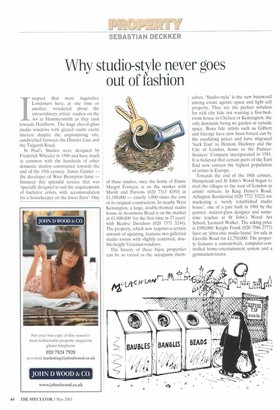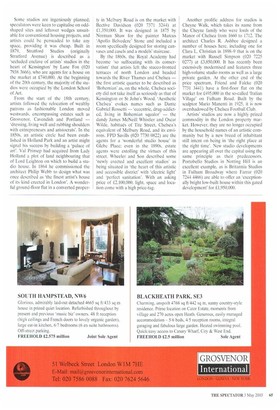Why studio-style never goes out of fashion
Isuspect that most inquisitive Londoners have, at one time or another, wondered about the extraordinary artists' studios on the A4 at Hammersmith as they rush towards Heathrow. The huge cheval-glass studio windows with glazed vaults excite interest despite the unpromising site, sandwiched between the District Line and the Talgarth Road.
St Paul's Studios were designed by Frederick Wheeler in 1890 and have much in common with the hundreds of other domestic studios constructed towards the end of the 19th century. James Gunter — the developer of West Brompton fame — financed this splendid terrace that was 'specially designed to suit the requirements of bachelor artists, with accommodation for a housekeeper on the lower floor'. One of these studios, once the home of Dame Margot Fonteyn, is on the market with Marsh and Parsons (020 7313 8350) at £1,100,000 — exactly 1,000 times the cost of its original construction. In nearby West Kensington, a large, double-fronted studio house in Avonmore Road is on the market at £1,900,000 'for the first time in 37 years' with Bective Davidson (020 7371 3244). The property, which now requires a certain amount of updating, features two galleried studio rooms with slightly contrived, double-height Venetian windows.
The history of these bijou properties can be as varied as the occupants them
selves. 'Studio-style' is the new buzzword among estate agents; space and light sell property. They are the perfect solution for rich city kids not wanting a five-bedroom house in Chelsea or Kensington, the only downside being no garden or outside space. Bona fide artists such as Gilbert and George have now been forced out by the escalating prices and have migrated 'back East' to Hoxton, Hackney and the City of London, home to the PainterStainers' Company incorporated in 1581. It is believed that certain parts of the East End now contain the highest population of artists in Europe.
Towards the end of the 18th century, Hampstead and St John's Wood began to rival the villages to the west of London as artists' retreats. In King Henry's Road, Arlington Residential (020 7722 3322) are marketing a 'newly refurbished studio house', one of a pair built in 1901 by the painter, stained-glass designer and sometime teacher at St John's Wood Art School, Leonard Walker. The asking price is £500,000. Knight Frank (020 7586 2777) have an 'ultra-chic studio house' for sale in Greville Road for £1,750,000. The property features a custom-built, computer-controlled home-entertainment system and a gymnasium/sauna.
Some studios are ingeniously planned; speculators were keen to capitalise on oddshaped sites and leftover wedges unsuitable for conventional housing projects, and artists could be persuaded to take any space, providing it was cheap. Built in 1879, Stratford Studios (originally Stratford Avenue) is described as a 'secluded enclave of artists' studios in the heart of Kensington' by Lane Fox (020 7938 3666), who are agents for a house on the market at £740,000. At the beginning of the 20th century, the majority of the studios were occupied by the London School of Art.
From the start of the 18th century, artists followed the relocation of wealthy patrons as fashionable London moved westwards, encompassing estates such as Grosvenor, Cavendish and Portland — 'dressing, living well and rubbing shoulders with entrepreneurs and aristocrats'. In the 1850s, an artistic circle had been established in Holland Park and an artist might signal his success by building a 'palace of art'. Val Prinsep had acquired from Lady Holland a plot of land neighbouring that of Lord Leighton on which to build a studio house. In 1864 he commissioned the architect Philip Webb to design what was once described as 'the finest artist's house of its kind erected in London'. A wonderful ground-floor flat in a converted proper
ty in Melbury Road is on the market with Bective Davidson (020 7371 3244) at £1,350,000. It was designed in 1875 by Norman Shaw for the painter Marcus 'Apollo Belvedere' Stone and included a room specifically designed for storing canvases and easels and a models' staircase.
By the 1860s. the Royal Academy had become 'so suffocating with its conservatism' that artists left the stucco-fronted terraces of north London and headed towards the River Thames and Chelsea — the first artistic quarter to be described as 'Bohemian' as, on the whole, Chelsea society did not take itself as seriously as that of Kensington or St John's Wood. 'Aesthetic Chelsea' evokes names such as Dante
Gabriel Rossetti 'eccentric, drug-addicted, living in Bohemian squalor' — the dandy James McNeill Whistler and Oscar Wilde. habitués of Tite Street, Chelsea's equivalent of Melbury Road, and its environs. FPD Savills (020 7730 0822) are the agents for a 'wonderful studio house' in Glebe Place; even in the 1890s, estate agents were extolling the virtues of this street. Wheeler and Son described some 'newly erected and excellent studios' as being situated in 'the heart of this artistic and accessible district' with 'electric light' and 'perfect sanitation', With an asking price of £2,100.000, light, space and location come with a high price-tag.
Another prolific address for studios is Cheyne Walk, which takes its name from the Cheyne family who were lords of the Manor of Chelsea from 1660 to 1712. The architect Charles R. Ashbee designed a number of houses here, including one for Clara L. Christian in 1898-9 that is on the market with Russell Simpson (020 7225 0277) at £3,850.000. It has recently been extensively modernised and features three high-volume studio rooms as well as a large private garden. At the other end of the price spectrum, Friend and Falcke (020 7731 3441) have a first-floor flat on the market for £495,000 in the so-called 'Italian Village' on Fulham Road. Built by the sculptor Mario Manenti in 1925, it is now overshadowed by Chelsea Football Club.
Artists' studios are now a highly prized commodity in the London property market. However, they are no longer occupied by the household names of an artistic community but by a new breed of inhabitant still intent on being in 'the right place at the right time'. New studio developments are appearing all over the capital using the same principle as their predecessors. Portobello Studios in Notting Hill is an excellent example, as is Britannia Studios in Fulham Broadway where Farrar (020 7244 4466) are able to offer an 'exceptionally bright low-built house within this gated development' for £1,950,000.











































































 Previous page
Previous page